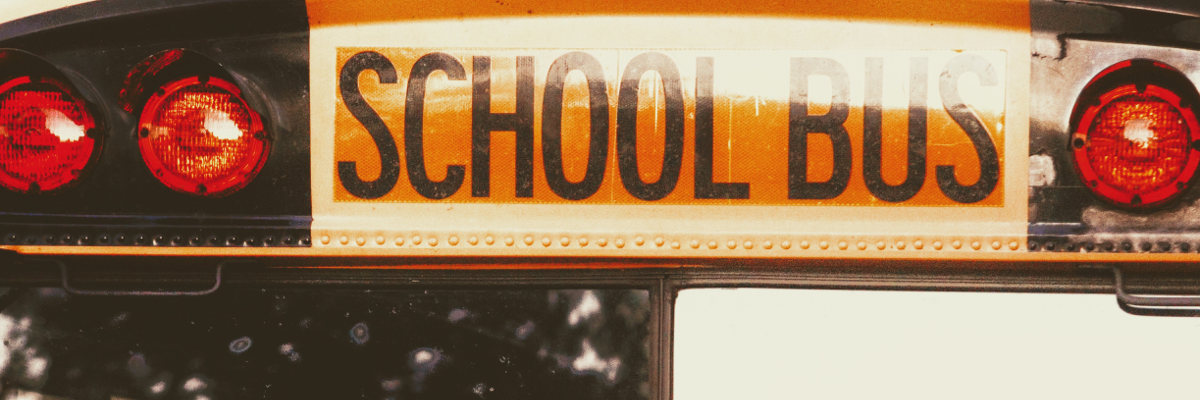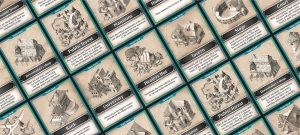The majority of today’s generations lives ecologically on credit, which has far-reaching consequences for future generations: Not only will they face enormous challenges in having sufficient natural resources, but also in coping with effects of the advancing climate change. While taking action now to reverse this trend, we must also consider preparing next generations for living more sustainably.
Recently, we talked about an SDG-inspired mobile game for kids and its importance for shaping the future towards sustainability on our blog. What about children’s education? Schools can significantly help next generations understand this complex, sometimes abstract topic. Taking it to schools implies many benefits, as both pupils and teachers will explore the sustainability issue, for instance. Moreover, implementing sustainable practices in schools is also beneficial to the administration as it may reduce costs in the long-term.
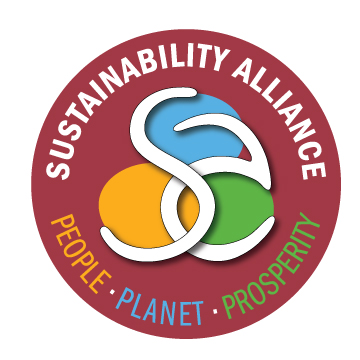
And is there any better way to learn than by playing games? Darcy Hitchcock from the Sustainability Alliance in Arizona has developed not one but two games which can be applied in the children’s education context: Sustainability in Schools for teachers and administrators, and Save the Climate for pupils. We had an opportunity to talk with her about the content and usage of both games, and her work at Sustainability Alliance, a network of organizations collaborating for a sustainable future.
Darcy, could you briefly describe what the games Sustainability in Schools and Save the Climate are about?
The Sustainability in Schools card deck can be used either as a game in a learning environment or in school as a planning tool. In teams, teachers and administrators go through a set of roughly 40 cards, each one representing something a school can do to be more sustainable, including actions associated with waste, water, purchasing and energy. Each card or action is rated based on the sustainability benefit (we used The Natural Step system conditions to score this) and the cost in both money and time to do it. The players develop a 2-year sustainability project plan, deciding what they will implement. If desired, the teams can be scored on cost/benefit, the highest sustainability benefit with the lowest cost+time score. This game/simulation shows educators the myriad of possible sustainable practices, points them toward those that make smart business sense, and helps them develop a logical implementation order for the projects. Then they can examine how to embed these projects into the classroom.
The Save the Climate board game has a board and a set of cards that represent personal actions that can contribute to or reduce greenhouse gases. The players read a card and ask if anyone at their table or their families does that action (e.g., the parent drives the child to school, or the student bikes to school). If someone does it, the card goes on the board as either increasing greenhouse gases or reducing them. After the players have eliminated all the cards, they score their collective climate impacts and then discuss ways to eliminate some of the harmful actions.
There are two versions of the board. The basic board simply asks players to distinguish between what contributes to or reduces greenhouse gases. The more advanced version asks students to distinguish whether the actions create methane or carbon dioxide and scores the methane emissions more harshly (since methane has a much higher climate impact).
This game helps the students feel responsible for their actions – both good and harmful. And because the scoring is at the team level, they are held jointly accountable, opening opportunities to talk about interdependencies and justice.
How did you and your team get the idea of creating games about sustainable practices and environmentalism in schools? What was your starting point?
I’ve been a fan of instructional games for decades. I published an article in TRAINING Magazine in 1988 called “Instructional Games and Simulations.” Back then one of my projects involved teaching line foremen (the people who supervise utility crews) Equal Employment Opportunity and Sexual Harassment laws. I knew lecturing them would never work so I built a board game where each player got $100,000 in play money and then had to start deciding if an action was discriminatory or not. If they got it right, they got a raise; if they got it wrong, they started forking over money to the harmed party and the attorney. In an hour, they went through 40 nuanced cases, some just okay, some not. And they loved it! Some asked me if they could buy the game to play with their buddies. I wondered if betting might be involved!
Anyway, fast-forward to 2015. A group of us in the Sustainability Alliance wanted to show our local schools how they could implement more sustainable practices and save money. Often the first action teachers think of is to put solar panels on the school. Not a bad idea but really expensive. In Arizona, our schools are strapped.
So we needed a way to expose the teachers and administrators to all the possibilities and help them choose among them, developing a strategy that could pay for itself with savings.
Someone on our team thought of Pokémon cards, where each card represents a different character with a different ability. That idea morphed into each card representing a different action and what emerged was the Sustainability in Schools Game.
Are the games focused on specific target groups? If yes, on which and why?
Increasingly schools are interested in embedding sustainability into their practices and curriculum but often teachers and administrators don’t know what to do. After recycling, they think about solar panels but there are a lot of other actions schools can take to save money, improve the sustainability of the school, and create opportunities for learning. The Sustainability in Schools Game is focused on teachers and administrators, those responsible for running the school. But it can also be used with school boards or even with the students, inviting their input into the sustainability plan.
The problem with teaching kids about climate change is that it can breed despair. We wanted a way to help kids see what they were doing to contribute to global warming but even more important, to see what they could do to turn things around. The Save the Climate Game is for K-12 (primary and secondary education). Depending on the sophistication of the students, the game can be made more difficult.
Let’s talk a bit more about the Save the Climate Game for kids. Are there any skills needed to play the game? Which new skills could be developed?
In the Save the Climate Game, a prerequisite is that students know what a greenhouse gas is. If the teacher prints the cards that reduce greenhouse gases on green paper and those that increase greenhouse gases on red paper, the students learn what makes the climate worse and better. If the cards are all printed on white paper, then the students must figure out whether the action saves or increases greenhouse gases. If they use the more advanced board game, they also have to understand the chemistry and different greenhouse gas impacts associated with methane and carbon dioxide.
Through the game, they learn to take responsibility for their actions and influence others to change behaviour. Math is required for scoring. Reading is of course required.
What are the most important lessons that can be learned from playing the game?
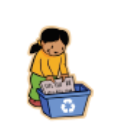
Students leave the game feeling empowered, knowing what they can do to make a difference. They also realize how interdependent we are. My behaviour may affect you.
What sustainability and educational goals can be achieved by using the game?
According to the Benchmarks for Educating for a Sustainable Future (a consensus document of Education for Sustainability thought-leaders defining what the field is) organizes the Big Ideas into three categories: Living on Planet Earth, Making Change and Taking Responsibility.
Living on Planet Earth: The Save the Climate Game teaches the mechanism through which humans are affecting the climate and how we can turn it around.
Making Change: They players collaborate to come up with practical solutions to reduce greenhouse gases in their own lives.
Taking Responsibility: Each player takes responsibility for their family’s behaviour.
What psychological and social processes may happen in and between players?
Because they are scored as a team, it raises a tension between individual freedom and collective benefit, the core challenge of any society. Do we have the freedom to emit all the greenhouse gases we want or do we need to influence societal behaviour?
Can you give any advice on how to facilitate game workshops?
It’s important that games not be an end in themselves. It’s not just about having fun or creating variety in the classroom.
There are a few places where games or simulations really make sense from a pedagogical perspective:
- when the content is dry or the audience unreceptive (like the line foremen and EEO).
- when the skills require complex interaction, socially and/or intellectually.
- when doing the task for real is too risky or dangerous, at least not without significant training (like pilots).
Some general tips:
- If you’re designing a game, leverage norms or game models that most people already know. Most people know to go clockwise around a board or how to play Jeopardy. Using familiar models will help participants focus on the learning, not how to play.
- Be careful about competition. It can amp up the level of interest but it can also hurt relationships. Think carefully about who should be on a team.
- Prepare a careful debrief to anchor the lessons the students should glean from them.
In which settings has the Sustainability in Schools Game been played? What results did you observe?
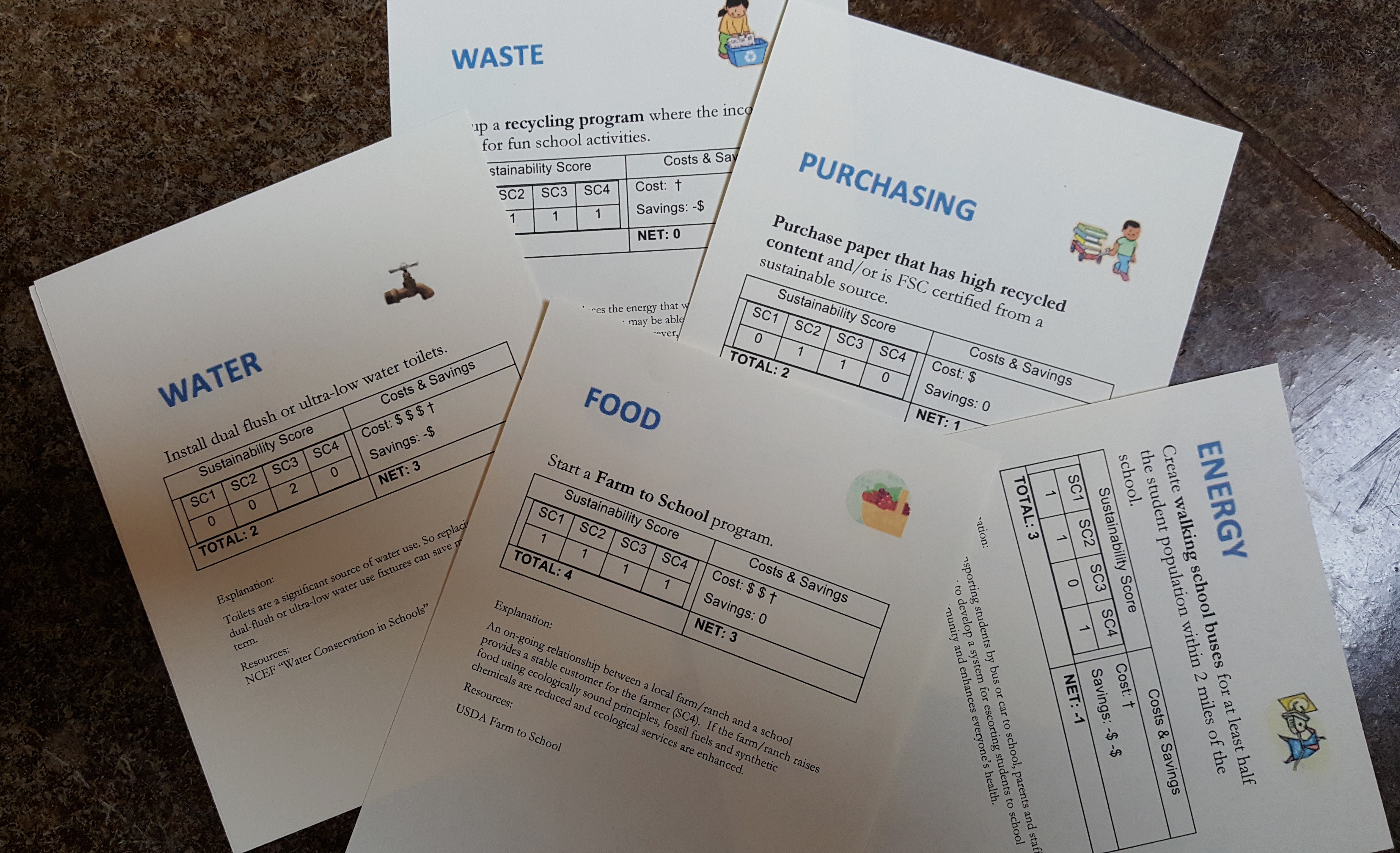
I’ve used the Sustainability in Schools Game at teacher conferences, as well as within a school to educate the staff about sustainability and also to help a school create a first-generation sustainability-plan. At a teachers’ conference, we demonstrated the game with perhaps 40 people. At the end of the game, I asked how many learned of new actions they could take in their schools. Almost all hands went up.
Did your work on the games change your perspective on the issues connected to climate change? If yes, how?
With Sustainability in Schools Game, I worked with a teacher to score each of the actions or cards. I learned that often time is more a constraint than money, so we added the effort required as a ‘cost.’ We also added to the debrief a ‘sanity test.’ I asked, ‘Can you really get all this done in two years or should we move some ideas to a later time?’
Probably the toughest thing about the Save the Climate Game was deciding if some actions ‘reduced greenhouse gases’ or not. What was the standard? For example, did riding the bus to school reduce greenhouse gases (over the default or worst case of every parent driving their kids to school) or should it count against the player because it still generates some greenhouse gases? In the end, we decided to score the cards as reducing greenhouse gases if they were better than the norm. But the game can be played in a more nuanced way. It’s up to the players to decide which can lead to a rich conversation after.
One last, more personal question. If you had to choose, what would be your three favorite serious games?
The irony is I’m not much of a game player. When I was a little girl, I remember taking the ‘Old Maid’ (the card you didn’t want to get stuck with) out of the deck. I sat on it. I didn’t like losing but I didn’t like making my friend sad either. So I’m not a big fan of artificial competition. (Read Alfie Kohn’s work on competition: No Contest: The Case Against Competition and Punished by Rewards.)
So I’m much more intrigued by games that are collaborative. I haven’t played it, but games like the World Peace Game seem really rich to me.
Both games can be downloaded for free under the Creative Commons License from the Sustainability Alliance website. Go to www.SustainabilityAllianceAZ.org and click on Education. Scroll down till you see a link to Educational Resources where these activities and other materials are available.
How did you like this interview? Let us know in the comment section or on our social media!
You can also fill this short survey to help us create better contentent for you!

